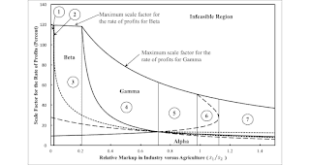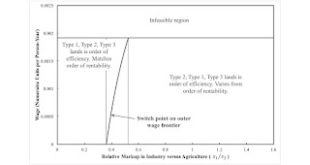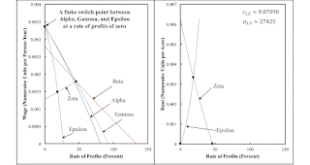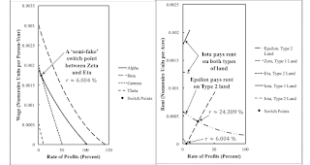Figure 1: Variation of Technique with Relative Markups1.0 Introduction This is a rewrite of a previous post with somewhat 'nicer' values for coefficients of production. I also expand on it with some observations on absolute rent. As far as I know, these posts are the first explicit presentation in the post-Sraffian tradition of a model of the prices of production with extensive rent and markup pricing. These posts explore the conflict over distribution among workers, capitalists, and...
Read More »Some Notes On Marx On Rent
Marx writes about rent extensively in Part II of Theories of Surplus Value and in volume 3 of Capital. I read Theories of Surplus Value decades ago. I have been trying to read the chapters of volume 3 on rent, that is, chapters 37 to 47. In general, these chapters do not use Hegelian terminology, but are just a matter of mathematical economics. Marx conflates analyses I would keep separate. Maybe this is a matter of a dynamic analysis set in historical time. I suppose I do not have...
Read More »Extensive Rent and Markup Pricing In A Complicated Example
Figure 1: Variation of Technique with Relative Markups "That 'diminishing returns' was not an essential element in the surplus-based theory emerged in Marx's criticisms of Ricardo. Sraffa (1960), in his short chapter on land, the implications of which have yet to be developed, shows how the classical view of rents need not necessarily rest on the conception of 'the law of diminishing returns' or need not suggest necessarily any functional relationship between output and cost, or even presume...
Read More »Marginalism As A Distortion Of Classical Rent Theory
I want to note some instances in the literature that argue that one strain in the marginal revolution was an extension of (a misunderstanding of) the theory of intensive rent in classical political economy to all factors of production, particularly capital. This this is not of only historical interest. It suggests that another approach, that of classical political economy, to value and distribution exists. Furthermore, a treatment of intensive rent exists that is opposed to marginalism, in...
Read More »Competitive Capitalism Rewards Inefficiency: The Production of Commodities with Extensive Rent and Markup Pricing
Figure 1: Order of Rentability Varying with Relative Markups1.0 Introduction Ownership is not productive, as Joan Robinson informs us. But, at least under competitive conditions one might hope, more productive assets earn their owners more than less productive assets. And this applies to scarce skills as well. But none of this is necessarily true, either. This article presents a numerical example in which, among scarce lands, rent per acre is higher on more fertile land only when...
Read More »Intensive Rent, Extensive Rent, And Absolute Rent
1.0 Introduction I have decided that this previous post is inadequate. If intensive rent exists on some type of land, the system of equations for prices of production cannot include a process that only partially cultivates some other type of land producing the agricultural commodity. So to form an example with both intensive and extensive rent, I need the technology to specify the possibility of cultivating at least three types of land. I might as well include markup pricing so as to...
Read More »A Fluke Case And The Disappearance Of Intensive Rent
Figure 1: Wage Curves For A Fluke Case1.0 Introduction This post examines perturbations around a fluke case in a model of intensive rent. The model illustrates an analysis of prices and the choice of technique in which the quantity of commodites produced matters. Yet the level and composition of net output are taken as given, independent of any variation, for example, from their dependence on distribution and relative prices. The model also illustrates a case in which prices of production...
Read More »The Reswitching Of The Orders Of Fertility And Rentability Revisited
Figure 1: A Part of a Parameter Space This post revisits my numerical examples in which I demonstrate the possibility of the reswitching of the order of fertility and of the reswitching of the order of rentability. Each of those posts presents a numeric example. In each, different ranges of the coefficients of production a0,2 and a1,2 are considered. This post combines those ranges, while still not considering the full parameter space, even for the slice for these coefficients. In the...
Read More »An Example Of Non-Uniqueness In A Model Of Extensive And Intensive Rent
Figure 1: Wage and Rent Curves for a Numeric Example1.0 Introduction This post continues, with some repitition, my exposition of a model of extensive and intensive rent. In the example, the cost-minimizing technique is non-unique at a low enough wage or rate of profits. One cost-minimizing technique, Epsilon, illustrates a case of extensive rent. The other cost-minimizing technique, Iota, illustrates a case with both extensive and intensive rent. In this technique, a kind of absolute rent...
Read More »Prices Of Production For A Model Of Extensive And Intensive Rent
This post continues the treatment of this model. A number of conditions must be satisfied by quantity flows and prices to allow the economy to undergo smooth reproduction. The net output of each produced commodity meets the requirements for use: (B - A) q = d The amount of each quality of land that is farmed cannot exceed the available quantity: C q ≤ t A vector is greater than or equal to another if each element of the vector is greater or equal to the corresponding element...
Read More » Heterodox
Heterodox






